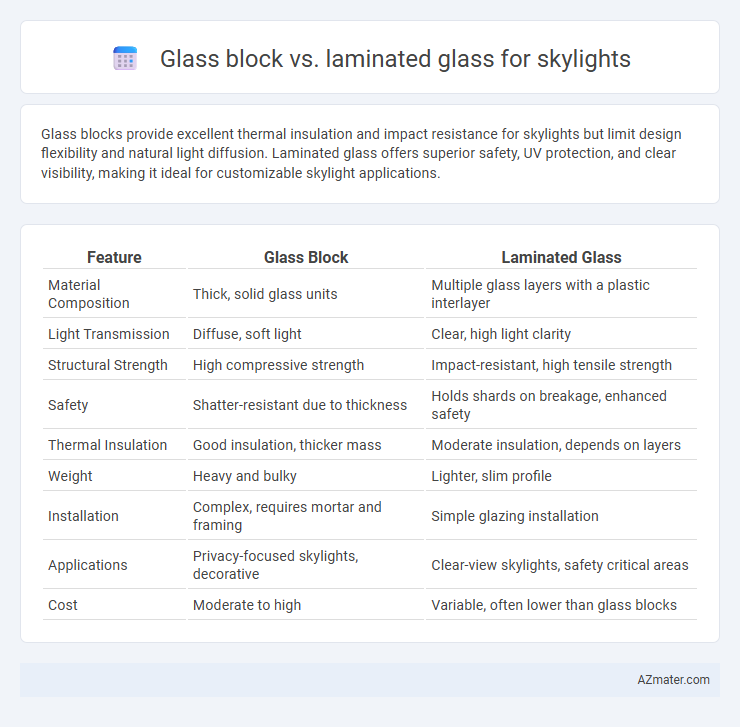Glass blocks provide excellent thermal insulation and impact resistance for skylights but limit design flexibility and natural light diffusion. Laminated glass offers superior safety, UV protection, and clear visibility, making it ideal for customizable skylight applications.
Table of Comparison
| Feature | Glass Block | Laminated Glass |
|---|---|---|
| Material Composition | Thick, solid glass units | Multiple glass layers with a plastic interlayer |
| Light Transmission | Diffuse, soft light | Clear, high light clarity |
| Structural Strength | High compressive strength | Impact-resistant, high tensile strength |
| Safety | Shatter-resistant due to thickness | Holds shards on breakage, enhanced safety |
| Thermal Insulation | Good insulation, thicker mass | Moderate insulation, depends on layers |
| Weight | Heavy and bulky | Lighter, slim profile |
| Installation | Complex, requires mortar and framing | Simple glazing installation |
| Applications | Privacy-focused skylights, decorative | Clear-view skylights, safety critical areas |
| Cost | Moderate to high | Variable, often lower than glass blocks |
Introduction to Skylight Glazing Options
Skylight glazing options primarily include glass block and laminated glass, each offering unique advantages in terms of durability and light transmission. Glass blocks provide excellent insulation and privacy, making them ideal for energy-efficient designs that require diffused natural light. Laminated glass excels in impact resistance and safety, often chosen for skylights where protection from weather and debris is critical while maintaining clear visibility.
Understanding Glass Block Skylights
Glass block skylights offer enhanced durability and privacy, featuring thick, textured blocks that diffuse natural light while providing superior insulation and impact resistance compared to laminated glass. Unlike laminated glass, which consists of multiple layers bonded for strength and clarity, glass block skylights create a distinctive aesthetic with their grid pattern and opaque design, ideal for spaces requiring glare reduction and security. The thermal efficiency and low maintenance of glass block skylights make them a practical choice for energy-conscious buildings seeking long-lasting performance without compromising on natural light.
What is Laminated Glass for Skylights?
Laminated glass for skylights consists of two or more glass layers bonded together with an interlayer, typically made of polyvinyl butyral (PVB), which provides enhanced safety and durability. This construction prevents the glass from shattering into sharp pieces upon impact, making it ideal for skylights exposed to weather and potential debris. Laminated glass also offers improved UV protection and sound insulation compared to traditional glass blocks, ensuring better energy efficiency and comfort in buildings.
Daylighting Performance Comparison
Glass block skylights offer moderate daylighting with diffuse natural light, reducing glare and providing consistent illumination, ideal for privacy-focused designs. Laminated glass skylights excel in allowing higher light transmittance and enhanced clarity, maximizing daylight penetration while offering safety benefits with its interlayer retaining shards upon breakage. Comparing their daylighting performance, laminated glass typically achieves superior luminous transmittance values (around 70-80%) compared to glass blocks (approximately 50-60%), making laminated glass more effective for spaces requiring abundant natural light.
Thermal Insulation and Energy Efficiency
Glass blocks provide superior thermal insulation for skylights due to their thick, multi-layered structure that reduces heat transfer and enhances energy efficiency in both hot and cold climates. Laminated glass, while offering excellent safety features and UV protection, typically has higher thermal conductivity, resulting in less effective insulation compared to glass blocks. Choosing glass blocks can significantly lower heating and cooling costs by maintaining stable indoor temperatures and minimizing energy loss through the skylight.
Safety and Security Features
Glass block offers superior impact resistance and shatterproof qualities for skylights, providing enhanced safety by preventing easy breakage and unauthorized entry. Laminated glass consists of multiple layers bonded with a durable interlayer that holds the shards together upon impact, reducing injury risk and deterring burglars. Both materials improve skylight security, but laminated glass excels in clarity and impact absorption, while glass block prioritizes rigidity and forced entry resistance.
Acoustic Insulation: Noise Reduction
Glass blocks offer superior acoustic insulation for skylights, effectively reducing external noise due to their thick, solid structure and internal air pockets that disrupt sound waves. Laminated glass also enhances noise reduction by using a special interlayer that dampens sound vibrations, but it may not match the mass and soundproofing capabilities of glass blocks. For optimal noise reduction in skylights, glass blocks are preferred in high-noise environments, while laminated glass provides a balance of acoustic performance and design flexibility.
Maintenance and Durability
Glass block offers exceptional durability and low maintenance for skylights due to its thick, solid construction and resistance to impact and weathering. Laminated glass provides enhanced safety with its interlayer preventing shattering, but requires regular inspection for potential delamination and seal failure caused by UV exposure. Both materials ensure longevity, yet glass blocks demand less upkeep over time, while laminated glass may need periodic resealing to maintain performance.
Aesthetic Design Possibilities
Glass blocks offer a distinctive, textured aesthetic that diffuses light while providing privacy, making them ideal for creating patterned skylight designs with a vintage or industrial charm. Laminated glass, with its clear, smooth surface, allows for greater transparency and versatility in incorporating colors, tints, or printed designs, enabling sleek, modern skylight appearances that maximize natural light. The choice between glass block and laminated glass for skylights significantly impacts the visual ambiance, with glass blocks emphasizing decorative opacity and laminated glass enhancing crisp, uninterrupted views.
Cost Considerations and Final Verdict
Glass blocks typically cost less upfront than laminated glass for skylights due to simpler manufacturing and installation processes, making them a budget-friendly option for projects emphasizing durability and privacy. Laminated glass, while more expensive, offers superior impact resistance, UV protection, and clarity, which enhances energy efficiency and safety in skylights, justifying the higher investment. For cost-conscious consumers prioritizing long-term performance and safety, laminated glass provides greater value despite higher initial expenses.

Infographic: Glass block vs Laminated glass for Skylight
 azmater.com
azmater.com